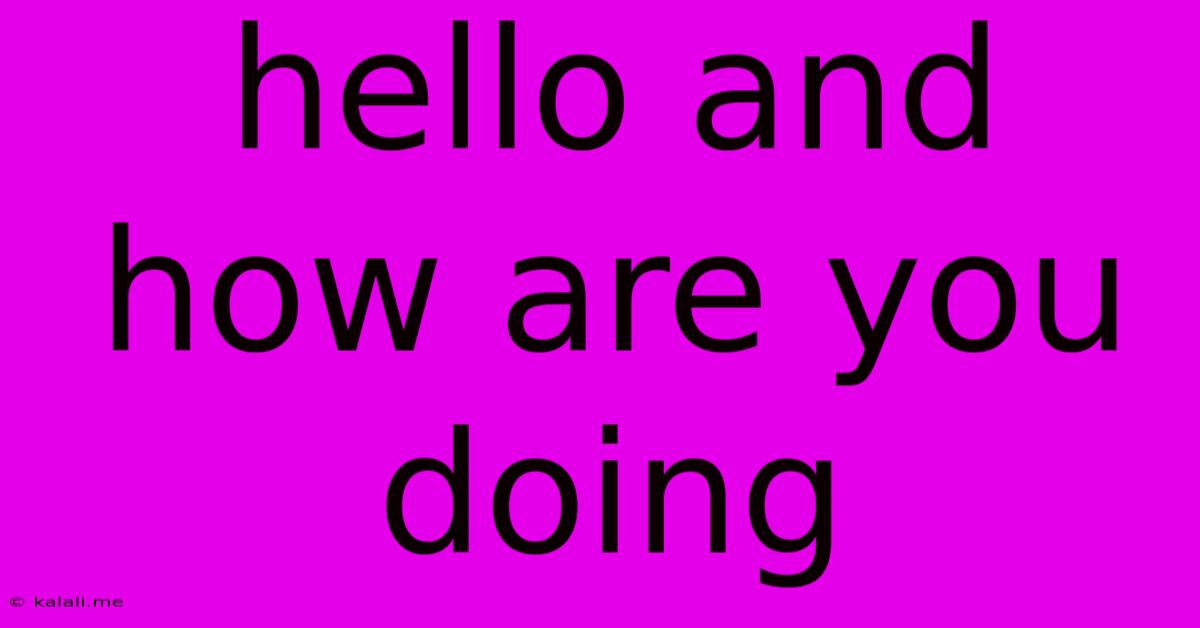Hello And How Are You Doing
Kalali
May 25, 2025 · 3 min read

Table of Contents
Hello and How Are You Doing: Mastering the Art of the Simple Greeting
The seemingly simple greeting, "Hello, and how are you doing?" is far more nuanced than it appears. It's the cornerstone of human interaction, a social lubricant that can set the tone for any conversation, from casual chats to crucial business meetings. This article delves into the intricacies of this everyday phrase, exploring its history, cultural variations, and the best ways to respond, ensuring you navigate social situations with confidence and grace.
This seemingly simple phrase is more than just a polite formality; it's a powerful tool for building rapport and connection. We'll explore its multifaceted nature, examining how context, tone, and body language all play a role in its effectiveness. Understanding this will help you use this greeting effectively in various settings.
A Brief History of "Hello"
While "hello" might seem ubiquitous, its origins are surprisingly recent. It emerged in the 19th century, evolving from the earlier greeting "hollo," an interjection used to attract attention. The adoption of "hello" as a standard greeting is a testament to its adaptability and ease of use across diverse social contexts. The evolution from a shout to a polite greeting reflects our ongoing societal shift towards more refined communication.
Cultural Nuances of Greetings
The simple "Hello, and how are you doing?" can take on vastly different meanings depending on the culture. In some cultures, it's a genuinely inquisitive question, prompting a detailed response. In others, it's a purely formal politeness, requiring only a brief, perfunctory reply. Understanding these nuances is crucial for navigating international interactions and avoiding unintentional cultural faux pas. Consider the varying levels of formality across different regions and the expectations around responding honestly versus offering a polite formality.
Beyond the Words: Tone and Body Language
The impact of "Hello, and how are you doing?" extends beyond the words themselves. A warm, friendly tone accompanied by a genuine smile conveys sincerity and openness. Conversely, a monotone delivery or a dismissive posture can negate the positive intent of the greeting. Paying attention to nonverbal cues is as important as the words themselves in creating a positive first impression.
Responding Appropriately: Navigating the Nuances of Reply
Responding to "Hello, and how are you doing?" requires careful consideration of the context. While a simple "I'm fine, thank you," is often sufficient, a more detailed response might be appropriate in close relationships or more intimate settings. Knowing when to provide a brief answer versus engaging in a more extended conversation demonstrates social intelligence and adaptability. This balance between polite formality and genuine connection is a crucial skill in effective communication.
Mastering the Art of the Simple Greeting
The seemingly simple "Hello, and how are you doing?" is a microcosm of human communication, highlighting the complex interplay between language, culture, and nonverbal cues. By understanding its history, appreciating its cultural nuances, and mastering the art of responding appropriately, you can elevate your interactions and build stronger connections with those around you. This seemingly small interaction forms the foundation of meaningful communication, shaping our daily experiences and influencing our relationships.
Latest Posts
Latest Posts
-
How To Recover Deleted Phone Numbers
May 25, 2025
-
I Didnt Think Id Get This Far
May 25, 2025
-
How To Find Median From Histogram
May 25, 2025
-
How Long Can Chicken Sit Out Cooked
May 25, 2025
-
What Does Popping A Cherry Mean
May 25, 2025
Related Post
Thank you for visiting our website which covers about Hello And How Are You Doing . We hope the information provided has been useful to you. Feel free to contact us if you have any questions or need further assistance. See you next time and don't miss to bookmark.